His war
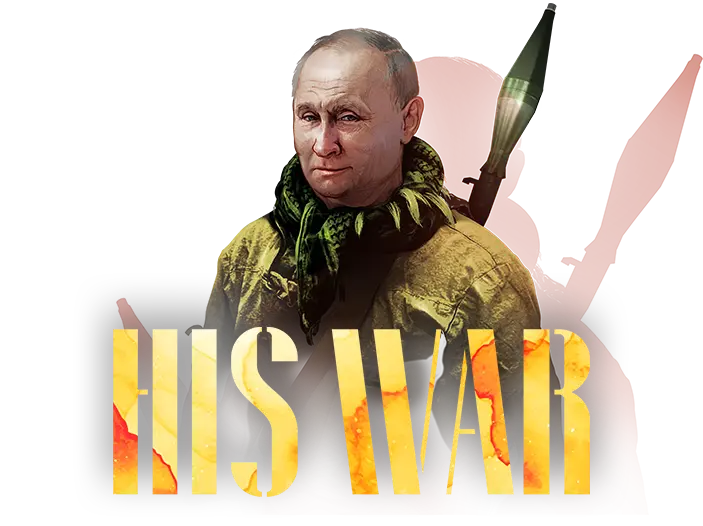
A film explaining how Putin started the war against Ukraine in 2014
“They tell us: ‘You started the war, Putin is the aggressor’. No, they are the aggressors, they started this war”. The Russian president keeps repeating these words, as if trying to convince himself that he was not the one who started the war against Ukraine in 2014. However, all the evidence – including the confessions of supporters of the “Russian Spring” – says that Putin is the one to blame for this massacre. Proekt has compiled all this evidence in its film “His War”.
Andrey Zakharov, November 28, 2023
This is the text version of Proekt’s film. It contains links to both the testimonies that we mention in the film and those that were not included in it.
In the summer of 2023, Putin met with pro-Kremlin war correspondents and once again explained that the war was started not by him, but by the insidious West, and that Russia was now “ending” it with the help of its army.
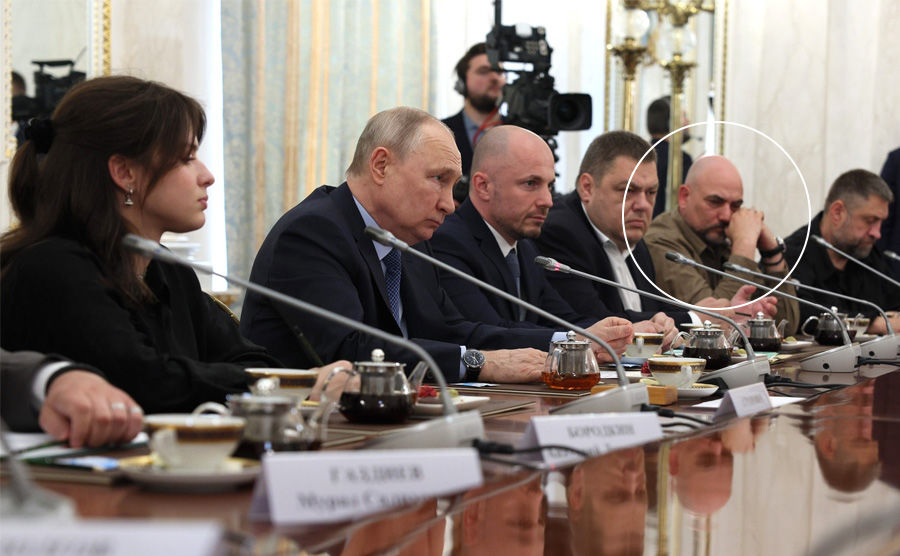
Dmitry Steshin, a war correspondent for Komsomolskaya Pravda, sat next to Putin at that meeting. He even asked a question about the grain deal. Instead of that, he could have challenged Putin’s version of how the war started in 2014. To do so, he would simply need to repeat his own words from the book “85 Days of Sloviansk.” The book is freely available in Russia, by the way.
Dmitry Steshin
[Strelkov’s] entire Sloviansk operation and the ‘Sloviansk sitting’ were meant to result in the introduction of Russian troops into the Donbas. Therefore, when the introduction was cancelled, it was a stalemate.”.
The “Sloviansk operation” was the arrival of an armed detachment led by Russian citizen Igor Strelkov from Crimea and his seizure of the Ukrainian city of Sloviansk in April 2014. In response, the Ukrainian authorities declared the ATO – “anti-terrorist operation”.
What “introduction of Russian troops” was Steshin talking about then? After all, the troops were only introduced in 2022 to “protect the people of Donbass”. And according to Putin, the spring of 2014 saw the beginning of a “civil war” in Ukraine, which – by his own version – Russia had nothing to do with.
There is no contradiction here. Unlike Putin, supporters of Russian aggression in Ukraine have long made it no secret among themselves that the Kremlin got involved in the war back in 2014. They see nothing wrong with it though.
The most outspoken of them all is, of course, Igor Strelkov.
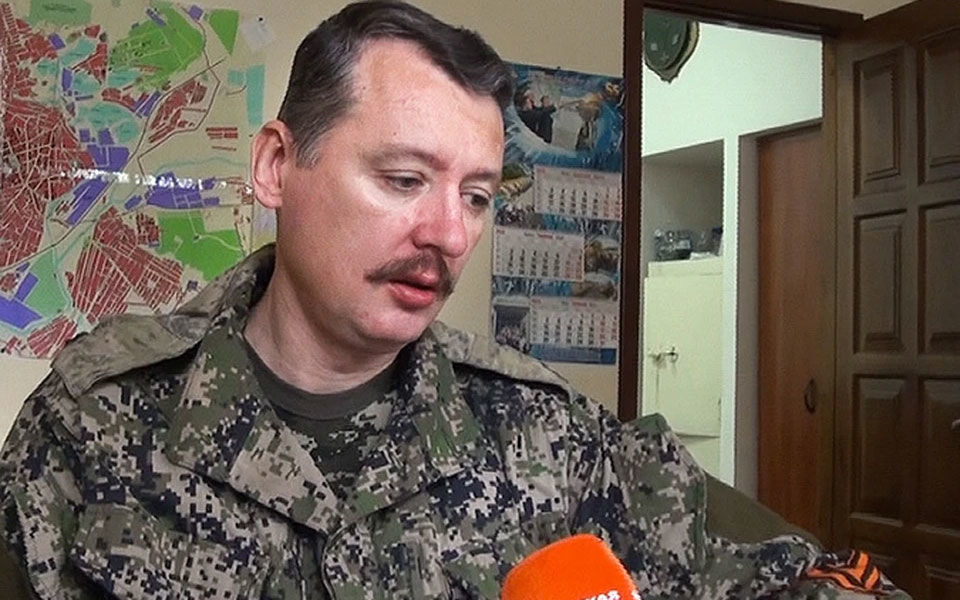
In late 2014, Strelkov honestly stated in an interview with the Zavtra newspaper that it was he who “pulled the trigger of the war”. This is Strelkov’s most famous revelation.
Igor Strelkov
“It was I who pulled the trigger of the war. Had our detachment not crossed the border, everything would have ended up like in Kharkiv or Odessa. There would have been a few dozen dead, burned, arrested. And that would have been the end of it. But our group set off the flywheel of the war, which is still going on now. We mixed all the cards on the table. All of them!”
Strelkov has often been candid on this topic. Here is a similar statement by him from 2020:
Igor Strelkov
“Had our detachment not come to the Donbas and become the core of the resistance, the core of the ‘Russian Spring’ in the Donbas, it is likely that without this core, the ‘Russian Spring’ would have been nipped in the bud.”
Okay, Strelkov is a Russian citizen and a former Chekist. He may be lying. But here are the revelations of Yevgeniy Zhilin, a Ukrainian citizen and one of the leaders of the Kharkiv Antimaidan, who was shot dead in 2016 in the Veterok restaurant near Moscow.

Yevgeniy Zhilin
“Only in Donetsk and Luhansk did the resistance develop into organised forms, solely because the first groups like Strelkov’s group appeared there and they had weapons […]. When there were huge protests from Kharkiv to Odessa, one mistake was made – people were not given weapons. Because of this, huge territories were lost, which can now only be regained by force.”
What do all these quotes tell us? It appears that the supporters of the “Russian Spring” themselves admit: without the arrival of Strelkov’s armed detachment, without military assistance from Russia in the form of weapons supplies, there would have been no war.
And, of course, this is not the only evidence that contradicts Putin’s version of how the war started. Since 2014, investigators from around the world have been collecting such evidence. This includes video recordings, satellite map data, hacked correspondence, wiretaps and, most importantly, recollections of those who personally took part in the bloody massacre, such as Strelkov himself.
Proekt has compiled all these pieces of evidence together — we have analysed both previously known evidence and that which our colleagues have missed. Our goal is simple – to understand who and how initiated the bloody series of events in 2014.
Support Proekt
Donate
Chapter 1
How Putin instigated the Maidan
In Putin’s lectures on the causes of the war with Ukraine, the key place is always occupied by the Euromaidan, i.e. the mass rallies in Kyiv in the winter of 2014, which escalated into a revolution against Viktor Yanukovych. It was the Maidan that started the turmoil, and, according to Putin, the blame for this turmoil is to be placed on the insidious West. It allegedly “directly interfered in the affairs of Ukraine”.
Vladimir Putin
“Europe actively supported the anti-constitutional armed coup in Ukraine. This is where it all started. What was the need to do this? Why did the USA organise this coup and the countries of Europe unwillingly supported it, provoking a split in Ukraine itself and the secession of Crimea from it?” — Putin said in 2021.
Accusing the West of interfering in Ukrainian matters, Putin casually omits the fact that he himself actually provoked the Euromaidan in every possible way.
Here we need to delve a bit deeper into the Ukrainian history. Back in 2004, the Orange Revolution took place in Ukraine. Pro-Western politician Viktor Yushchenko became president. Yushchenko immediately announced that Ukraine would be seeking EU association and NATO membership. Ukraine’s drift towards the West infuriated Putin, but it seemed like he could calm down in 2010 when Viktor Yanukovych became president.

Yanukovych had the image of a pro-Russian politician – before the election, he opposed Ukraine’s rapprochement with NATO and advocated protection of the Russian language. Once in power, however, he tried to balance between the West and Russia. For instance, Yanukovych did not give up on EU association. This provided votes for the pro-Western electorate. The EU authorities welcomed this course in every possible way.
Of course, one could argue that Yanukovych dragged Ukrainians where they didn’t want to go. But at the turn of 2012-13, about 50% of Ukrainians were in favour of EU association (poll data 1, 2). Southeast Ukraine was more in favour of joining the Eurasian Customs Union, an economic union led by Russia.
How Ukrainians answered the question about possible European integration
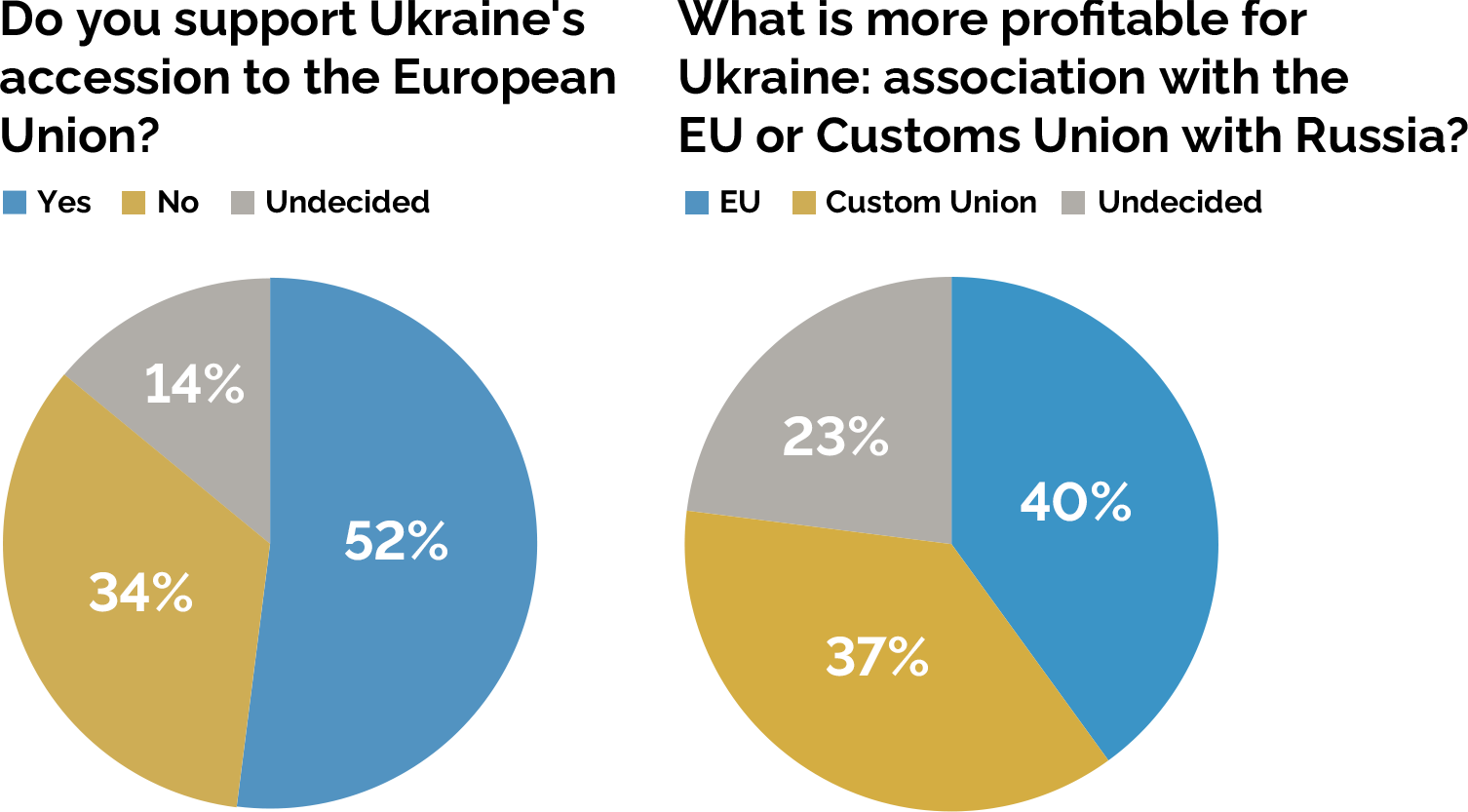
Research data from the sociological group “Rating”, December 2012
Obviously, it was a difficult choice for the Ukrainians. But the Kremlin had already made it for them, deciding that they absolutely needed to join the Customs Union. For their own good.
In August 2013, the Ukrainian media published a plan to force Ukraine into the Customs Union. Allegedly, it was drawn up somewhere in the Kremlin.

The objectives outlined in this plan were quite ambitious. Firstly, Ukraine should not join the EU under any circumstances. Secondly, “the idea of joining the Customs Union should be imposed on Ukraine”, which includes organising protests there.
This was essentially a plan to interfere in the neighbour’s affairs. To do what Putin constantly accuses the West of doing.
But what if the plan to drag Ukraine into the Customs Union was a fake? Let’s see if we can authenticate it.

This is Kirill Frolov, a Russian citizen and active Orthodox activist. Frolov was associated with two figures who played an important role in the events of 2013-2014. Firstly, Frolov worked at the Institute of CIS Countries under State Duma member Konstantin Zatulin. Secondly, he was an informal assistant to Sergei Glazyev, Putin’s advisor and chief curator of Ukraine in the Kremlin in 2013.
In 2014, Glazyev commanded the storming of Ukrainian regional administrations from Russia and sent Frolov to Odessa. And Frolov was responsible for financing the so-called “anti-Maidan”.
Around 2016, Ukrainian hackers broke into Frolov’s email account. This leak has become one of the important pieces of evidence on Russia’s interference in Ukrainian affairs. Out of this whole dataset, we are now interested in Frolov’s correspondence with a mysterious person with the initials SVV and an account on the domain of the Institute of CIS Countries.
In August 2013, Frolov shared with SVV a link to a published plan to force Ukraine into the Customs Union. And SVV confirmed to him: “This is a real document”. In other words, this wasn’t a fake, it wasn’t made up by liberal media or the Ukrainians.

Frolov regularly sent exclusive information about the situation in Ukraine to the mysterious SVV. So who is this SVV?
Leaked databases show that SVV was Valery Viktorovich Solokha. As of 2015, Solokha was officially listed as an adviser to the director of the Institute of CIS Countries.
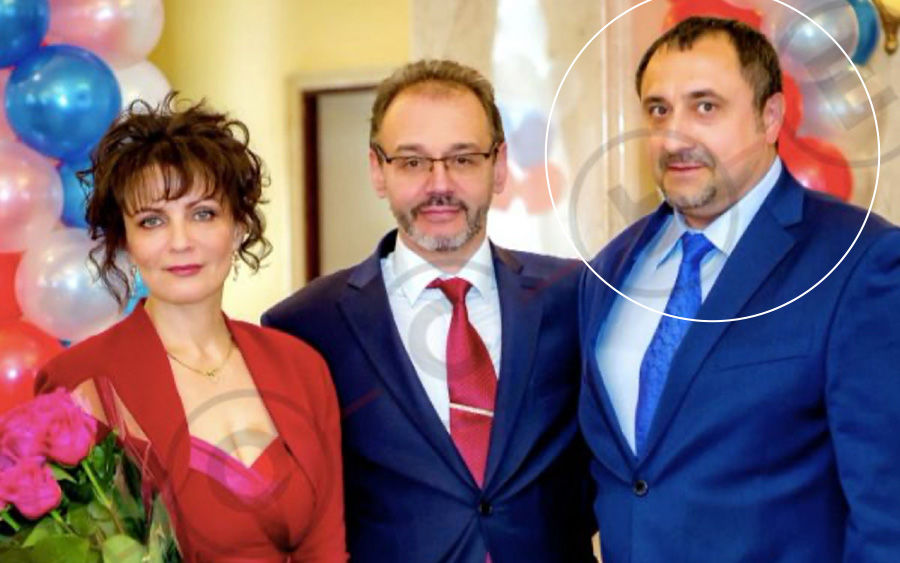
It turns out that he didn’t just work at the Institute of CIS Countries. Another leak indicates that he also worked for the FSB. In a few years Solokha will be in charge of Moldova and Transnistria in the same FSB Fifth Service that convinced Putin they’d roll out a red carpet for him in Ukraine in 2022, as iStories and The Washington Post reported.
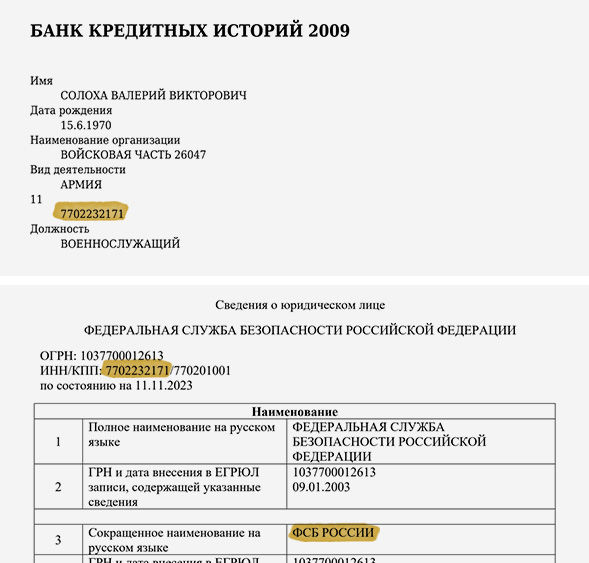
Thus, the authenticity of the plan to force Ukraine into the Customs Union was confirmed by not just anyone, but an actual high-ranking officer of the FSB.
In 2013, the Kremlin did everything to make Ukraine turn from the European Union to the Customs Union at the last moment. All in accordance with that very plan. The battle for Ukraine and Yanukovych’s choice unfolded on diplomatic, trade, propaganda and even military front (which wasn’t so frightening back then).
During 2013, Putin and Yanukovych met more than five times. They even kissed the same icon in the centre of Kyiv. Putin constantly hinted that if he chose the EU and rejected the Customs Union, problems would ensue immediately. Then, after scaring Yanukovych with the stick, Putin would switch to the carrot.
Vladimir Putin
“If Ukraine joins the Customs Union, this will result in GDP growth of between 1.5 and 6.5 per cent for Ukraine […]. But from the socio-economic point of view, it seems to me that today, there are no serious experts in either Ukraine or Russia who do not believe this to be an extremely positive process for Ukraine.”
Putin pressured Yanukovych at private meetings, while ordinary Ukrainians were pressured by Putin’s adviser Glazyev and his close friend Medvedchuk. Throughout 2013, they travelled around Ukraine telling Ukrainians how bad life in the EU would be for them and how good it would be with Russia (footage from Donetsk, Luhansk and Kharkiv). Glazyev minced no words when assessing Ukraine’s course towards Europe.
Sergey Glazyev
“We can see that our strategic partner is going for an outright colonial deal, sacrificing its sovereignty and economic interests.”
Once again: a high-ranking Russian official – an advisor to the president – was travelling around Ukraine and criticising its government in the most uninhibited terms. By the way, it was most likely in Glazyev’s office that this plan to put pressure on Ukraine was prepared. One cannot help but recall these words by Putin:
Vladimir Putin
“We never interfere in the political affairs, in the political processes of other countries.”
All these threats by Putin and Glazyev were merely verbal interventions. How can one make the citizens of Ukraine realise here and now how bad it will be for them if they choose the EU over Russia?
That’s right – block supplies of goods from Ukraine.

In mid-August, Russian customs began strict checks of goods from Ukraine at the border. All goods were unloaded, re-weighed, sampled. Exports were paralysed for a week.
Украину откровенно припугнули — что будет с ее экономикой, если она не прислушается к путинским угрозам. Вот риторика Глазьева и Путина того времени.
“We still have the option of withdrawing from the free trade relationship with Ukraine. For Ukraine, this would mean an economic catastrophe.”
“I am afraid that this may result in deindustrialisation in certain sectors of production. But the choice is always ultimately up to Ukraine.”
Putin showed his concern for Ukraine’s economy nine years later, when the Russian army began bombing the neighbouring country. But in 2013, military pressure was also applied, albeit only symbolically at first.
In 2013, the Russian army underwent several surprise readiness inspections for the first time since the collapse of the USSR. According to an archive issue of Krasnaya Zvezda, the first of these took place in February. Then the Black Sea Fleet manoeuvres followed in March. Here is what the Zvezda TV channel told about them:
“Today, Black Sea Fleet ships conducted live firing exercises and also carried out a landing of troops on an undefended coast near Feodosia. The operation involved Su-24 attack aircraft. They supported the marines from the air”.
Sounds familiar, doesn’t it? They landed troops in the Crimea, near Feodosia. On the one hand, that’s not a big deal – after all, there was a perfectly legal base of the Black Sea Fleet in Crimea at that time. It’s just that exactly a year later, when Russia annexed Crimea, the landing was a genuine one. Ukrainian politicians and Western experts later claimed that during the 2013 exercises, Russia was most likely practising how it would annex Crimea and fight a hybrid war against Ukraine. Such exercises would later become a convenient camouflage for moving troops to the Ukrainian border and into its territory.
So, what do we have? Political and economic pressure on Ukraine. Saber-rattling. Zero hour was approaching: in late November Yanukovych was to sign the agreement with the EU. So in autumn, a master of political intrigue was brought in to assist Glazyev: Vladislav Surkov. Putin appointed him as his aide, primarily in Russian-Ukrainian relations.
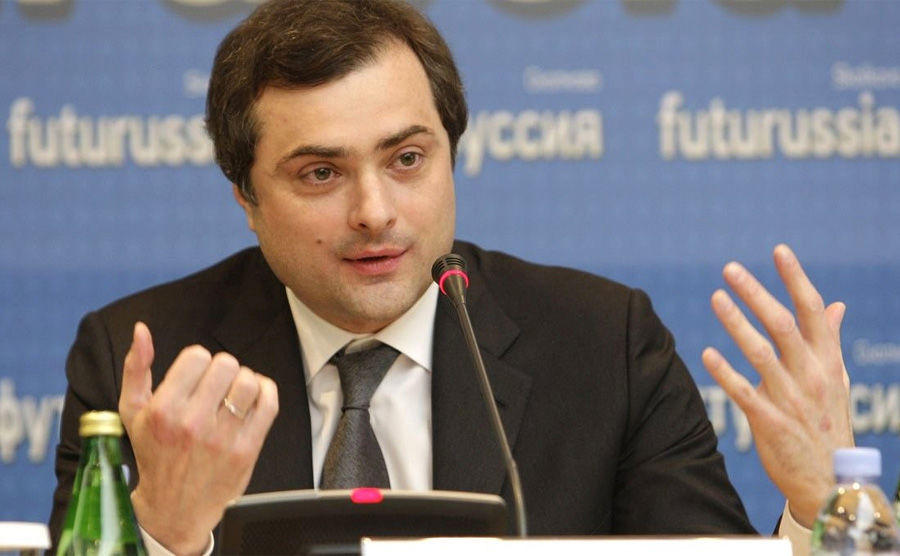
In 2016, Ukrainian hackers hacked into the email account of Surkov’s public office. This leak became one of the proofs of Russia’s active interference in Ukraine’s affairs. There’s thousands of emails here. There are even passport scans of Surkov and his family. It’s impossible to fake something like that.
It follows from the Surkov leak that the Kremlin was receiving information that Ukrainians’ preferences have not changed. Despite Russia’s economic, political and even military pressure. The leak contains poll data from early 2014 with the following figures: if the choice of Ukrainians was determined in a referendum, 58% of voters would vote in favour of association with the EU. An overwhelming majority. 42% would vote for the Customs Union with Russia.

In short, the Kremlin’s pressure had no effect on Ukrainians. But it did affect the weak Yanukovych. The Ukrainian government confirmed its course towards European integration back in September. But then Yanukovych started faltering and flew several times to meet with Putin, including secret meetings. Ultimately, just days before signing the agreement with the EU, Yanukovych panicked and decided to take a course towards the Customs Union. His prime minister Mykola Azarov later explained that the reason was Russia’s pressure.

Ukrainians who favoured European integration protested on Independence Square (or Maidan Nezalezhnosti) in the centre of Kyiv. The protest, dubbed “Euromaidan,” gradually grew, and was supported by part of Ukraine’s political elite and Western officials. Yanukovych threw security forces at the protesters. A real massacre began in the centre of the European capital.
Two weeks before the people of Kyiv took to the Independence Square, the final concert of the rock tour “We Are United” was held there. The tour was organised by Medvedchuk and Glazyev. A Kuban cossack choir, Chaif, and Putin’s favourite band, Lyube, were sent to campaign for a union with Russia. Kyiv residents waved flags of Ukraine and Russia, a scene that would soon become completely unimaginable.

Of course, history knows no “if”, but what would have happened if Russia had not pressed Yanukovych, deciding that it knew better than the Ukrainians what they needed? Economic collapse, as predicted by Putin and Glazyev? Rapid growth alongside the European Union? It is impossible to say, but if we go back to Putin’s words, there would have been no war in the Donbas without the Euromaidan. And there would have been no Euromaidan without Yanukovych rejecting the union with the EU.
In other words, if anyone is to blame for the Euromaidan, it is Putin.
Subscribe to our mailing list (in Russian)
Подписаться
Chapter 2
How Putin annexed Crimea
You can easily buy a copy of the medal “For the Return of Crimea” in Russian online military shops for a couple hundred roubles.
Russian Defence Minister Sergei Shoigu instituted it in late March 2014 – shortly after the Crimean referendum. The list of recipients is an important source of information about who took part in the annexation of Crimea. Take a closer look at the inscription.
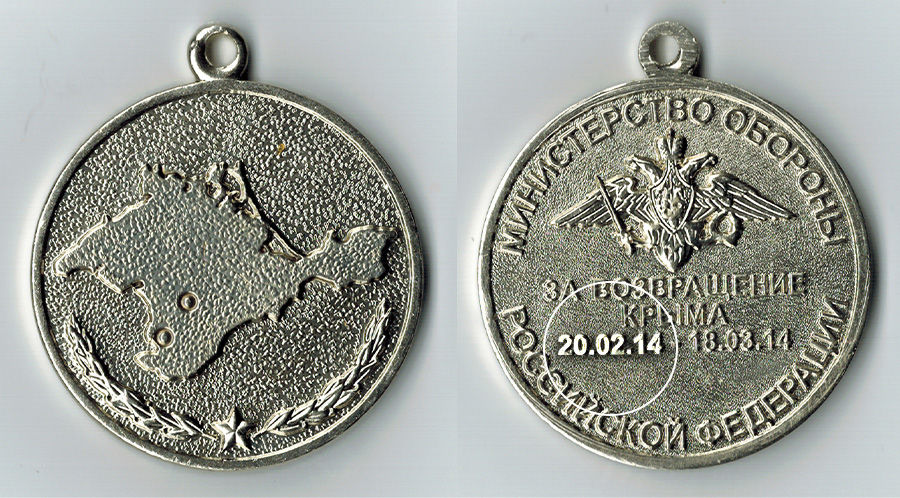
“Ministry of Defence of the Russian Federation. For the return of Crimea. 20 February 2014”
Notice anything wrong? Explaining the decision to launch the operation to “return” Crimea, Putin indicates the “coup d’état” as the starting point.
Vladimir Putin
“We never thought about detaching Crimea from Ukraine until the events (on the Maidan), the coup, began”, — these are his words from the film “Crimea. The Way Home”.
Putin calls the events of 21 February a “coup d’état”. By that time, the confrontation on the Maidan had already lasted for over two months. On 21 February, President Yanukovych signed an agreement with opposition leaders to resolve the political crisis. However, it was not accepted by the protesters, and Yanukovych fled the capital on 22 February, essentially yielding power to his opponents.

So, according to Putin himself, he made the decision to annex Crimea after the events of 21 February. But the medal has a different date on it – 20 February. Yanukovych was still the legitimate president, there was no “junta” as Putin likes to call it.
Ukrainian journalist Ruslan Tsymbalyuk once asked Russian Foreign Minister Lavrov about this chronological paradox. “I have not seen this medal, but I think it is just some technical misunderstanding.”, — Lavrov responded.
That’s quite some misunderstanding, seeing how it’s a medal of the Ministry of Defence, instituted by Shoigu’s order. By the way, it was not only Ukrainians who asked about the strange date. The man who was one of the first to be awarded this medal also asked the same question.

This is Sergei Gorbachev. Former officer of the Black Sea Fleet and journalist from Sevastopol. In the 90s, the Ukrainian authorities even tried to imprison him for his open pro-Russian stance. In his book dedicated to the anniversary of the “Crimean Spring”, Gorbachev answers the question about the date in the following way: it was around 20 February when the first special forces units , who’d later be called the “polite people”, began their covert deployment. Russia simply used its opportunity and right to increase its Crimea contingent.
The Ukrainian authorities also consider 20 February as the start of the Russian aggression in Crimea. According to Kyiv, the transfer of troops to the peninsula began on that date. This date is even documented in a special resolution of the Verkhovna Rada.
So, the takeover of Crimea began before Yanukovych fled – before the “coup d’état” that, according to Putin, prompted his decision to “return Crimea”.
Long before that, the Kremlin began working with the Crimean elites and pro-Russian politicians. One of those engaged in it was Konstantin Zatulin.

Zatulin is one of the key figures of the “Russian Spring”. State Duma deputy and director of the Institute of CIS Countries. Zatulin’s adviser at the institute was a high-ranking FSB officer Valery Solokha. “Zatulin likes to tell stories of how they celebrate Victory Day with his friends from military counterintelligence,” another institute employee Kirill Frolov wrote to Solokha in late 2012.
Zatulin has always openly declared that Crimea should become part of Russia. For this he was banned from entering Ukraine several times. Under Yanukovych, Zatulin’s ban was lifted, and in early February 2014, he came to Sevastopol to meet with Crimean Cossacks. At that meeting, Zatulin spoke about the need to “federalise” Ukraine, while the Cossacks asked whether Russia’s Black Sea Fleet would help them in the fight against the “Banderovites”.

Judging by Frolov’s leaked emails, Zatulin arrived in Crimea in a new status. Here is an excerpt from one of the letters: “Now Zatulin is in charge of Ukraine. This is great for us, he’s an informal curator of the anti-Maidan movement…” So, if Frolov is to be believed, Zatulin became the curator of the political protests that were then unfolding in the cities of southeastern Ukraine to counter the Euromaidan.
On 25 February, by his own admission, Zatulin came to Crimea again. Russian military personnel without insignia were already roaming the peninsula, but they had not yet entered the Crimean parliament building armed with assault rifles.
Nowadays, the norm is to call each other over the Internet if you are afraid of being wiretapped. But in 2014, both Russian politicians and pro-Russian activists communicated with each other in Ukraine via regular phone calls. The SBU, of course, intercepted these conversations, and they became one of the most important pieces of evidence of Russian interference.
Here is a conversation between Zatulin and Sergey Glazyev from late February 2014. Zatulin was in Simferopol, while Glazyev was apparently in Russia. Zatulin and Glazyev claimed that the recording was a “compilation and falsification done by the SBU”.
Konstantin ZatulinYou know, I’ve already started transferring money from my Institute with the help of Western Union. I have already transferred about $25,000.
Sergey GlazyevHow much do you need, tell me?
Konstantin ZatulinWell, given the expenses that may be forthcoming, up to $50,000, I think. Tomorrow.
Sergey GlazyevYeah.
Konstantin ZatulinI need it right here. So that we can work.
Sergey GlazyevGood.
Why did Zatulin need such money? Well, it was hardly to have a nice holiday in the spring Crimea. It is clear that there were enough activists and politicians on the peninsula who did not need to be bribed – Crimea had long been known for its pro-Russian sentiments. But it was necessary to work with them as well.
Orthodox millionaire Konstantin Malofeev volunteered to finance the anti-Maidan.
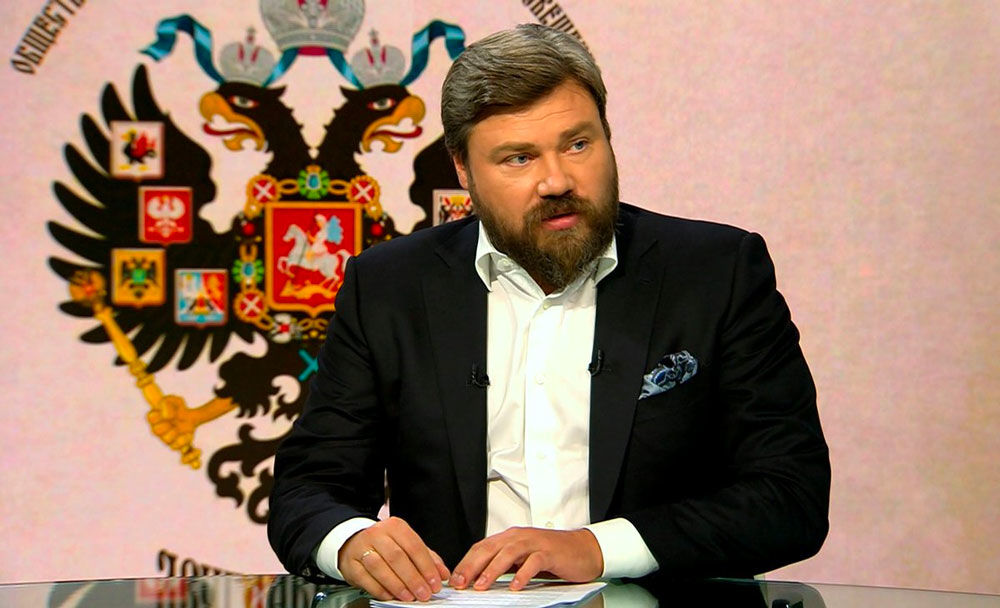
We can learn from Kirill Frolov’s correspondence how the Kremlin got Malofeev on board with the Ukrainian agenda. In September 2013, Frolov was emailed by one of Malofeev’s Orthodox associates, Alexey Komov.
Alexey Komov
“Let’s organise a meeting between Glazyev and Konstantin Malofeev about saving Ukraine from homo-Euro-integration – he has concrete proposals and resources.”, — he wrote using the distinctive language of Russian Orthodox fundamentalists.
Glazyev was fine with this. The meeting apparently took place in Malofeev’s office in Moscow.
In January 2014, Malofeev fulfilled an important political mission: in the midst of the Maidan, he brought Christian relics – “gifts of the Magi” – to Kyiv.
The safety of the relic was the responsibility of Igor Girkin, a former FSB officer and Malofeev’s chief of security; in a few months, the whole world would know him as Igor Strelkov.
Igor Strelkov
“During our time in Kyiv, I took the time to visit the Maidan on foot and one night travelled through it in a taxi. Malofeev did not instruct me to visit the Maidan or monitor its activities. I did not watch or recruit anyone in Kyiv.”, — he later recalled.
From Kyiv, Malofeev took the gifts of the Magi to Crimea, and there he took full advantage of the opportunity to talk to the local elites.
Dmitry Sablin, head of the Combat Brotherhood movement and State Duma deputy, flew to Crimea together with Malofeev. While the believers were praying, they met with Crimean officials. They were promised that if Crimea opts for independence, Russia will not see that no harm comes to the peninsula.
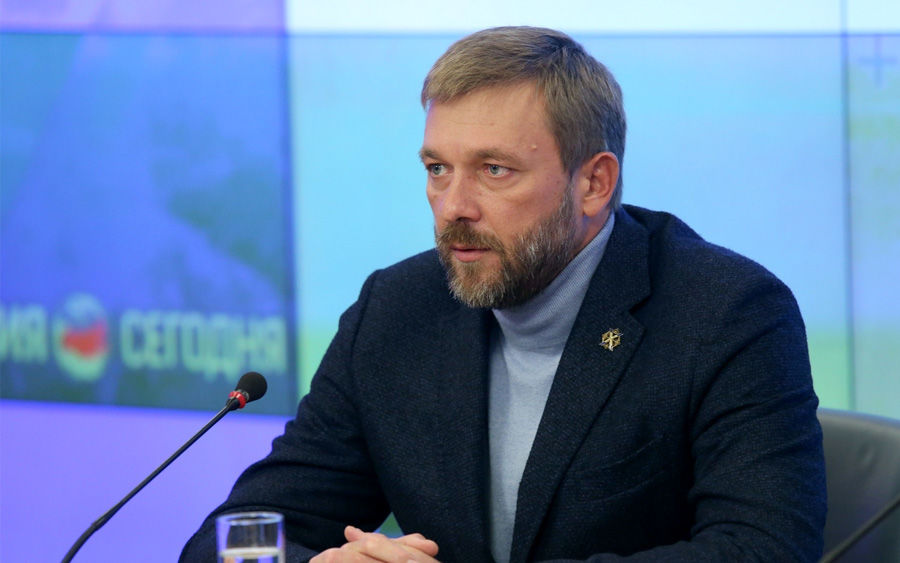
One of the Crimean officials, Deputy Prime Minister Rustam Temirgaliev, later cited the following dialogue:
“In a discussion with Malofeev and his companions on the bus, I said: ‘Let’s assume that there will be complete chaos in Kyiv. How shall we act?’ They replied, ‘We need to raise the banner of an independent or at least absolutely autonomous Crimea.’”
Strelkov did not waste any time during that visit either. Here is what he recalled later:
Igor Strelkov
“Having been to the Maidan in Kyiv, having spoken to people there, I realised that Ukraine was going to fall apart in the near future […]. Accordingly, when I arrived in Crimea, I started to work on establishing local contacts quite independently, without having had conversations with Malofeev yet. At that time I also met Aksyonov, as his Cossacks were guarding the gifts of the Magi in Simferopol. It was also then that I established contact with the officers from the fleet headquarters.”

At that time, Sergey Aksyonov was just a Crimean MP from the marginalised “Russian Unity” party, which declared that it was defending the rights of Russians in Ukraine. A few months later, this man, who may have had criminal ties in the past, would take over the Russian-occupied peninsula.
At the same time, in early February, Putin’s Ukraine aide Vladislav Surkov also arrived in Crimea. He also met with local politicians. He had a formal reason – the construction of the Kerch bridge. At the time, it was a joint investment project between Russia and Ukraine.
In Crimea, Surkov met with local politicians. Upon his return to Moscow, he told his entourage: without Russia’s support, the Crimean elites and pro-Russian activists are not capable of taking power. This is what our source in his entourage tells us.
One of those with whom Surkov met was the Chairman of the Supreme Council of Crimea, Vladimir Konstantinov.

He soon travelled to Moscow and suddenly declared in the State Duma: Crimea may secede from Ukraine if Yanukovych’s rule falls as a result of the protests in Kyiv. That was on February 20, the date on the Ministry of Defence’s medal.
The same Russian politicians who were there a few weeks earlier return to the peninsula. Now they help the Russian military seize the territory of Ukraine. Some, like Igor Strelkov, are using Malofeev’s money.
Igor Strelkov
“I have been in Crimea since 21 February. The MPs were gathered by the militias and brought into the assembly hall. Yes, I was one of the commanders of these militias”, — he recalled.
Zatulin arrived in Crimea no later than 25 February and was one of the Kremlin’s main “curators” of the takeover of Crimea. And one of the Combat Brotherhood leaders, Sablin, who came to Ukraine with the “gifts of the Magi” in early February, was now persuading Ukrainian soldiers to swear allegiance to Russia.
To help the military and pro-Russian activists, a troop of “tourists” – the Ukrainian term for Russians who came to Ukraine in the spring of 2014 to participate in the protests – was thrown in.

For example, State Duma deputy Frants Klintsevich brought 200 Afghan war veterans.
Dmitri Galochkin
“I’m amazed at Mr. Klintsevich’s modesty. He summoned us to his office and said: ‘You are coming with us to Crimea’. On February 27, the day of ‘polite people’, we gathered 200 ‘tourists’. And we were there.”, — Afghan war veteran Dmitri Galochkin revealed in 2019.
Don Cossacks also arrived to help the local ones, who had already been riled up by Zatulin. Their dispatch was supervised by ataman and State Duma member Viktor Vodolatsky.
Nikolai Dyakonov
“I came to the Commander of the Black Sea Fleet, where the Chief of Staff of the Southern Military District was also present. I was given a task, which I will not fully disclose […]. Initially there were about a hundred people […]. We received tasks from the Ministry of Defence”, — recalls marching ataman Nikolai Dyakonov
Those who would later become infamous after the events in Donbas were also involved in the seizure of Crimea. Malofeev’s PR man and future Prime Minister of the DPR, Aleksandr Borodai, worked as Aksyonov’s adviser during these days. In addition, a troop of Transnistrian state security officers with ties to the FSB landed in Crimea. Among them was the future Minister of State Security of the DPR Andrei Pinchuk.
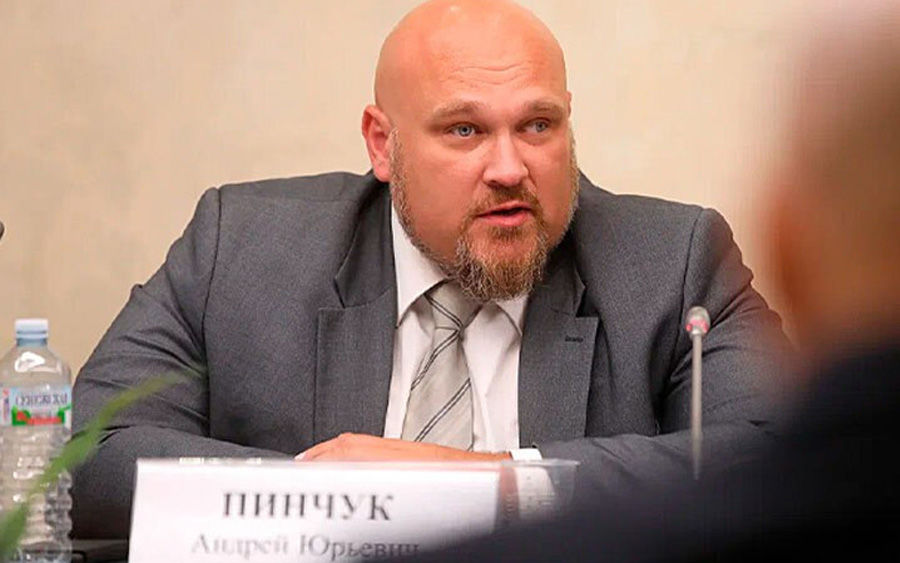
Here is how he himself recalled those days in Crimea in his book, which is freely available in Russia. Pinchuk had just flown to the peninsula from Moscow.
Andrei Pinchuk
“In Simferopol, our contact, a local businessman named Viktor, was waiting for us.
He stood next to the building of the Crimean Council of Ministers, looking round slyly, and suggested that we move into rented flats, and then “we’ll see”.
– Vitya, what are we supposed to “see”? You should clarify the task on the spot.
– You must take control of the SBU! You will move in tomorrow with our armed cover”.
In short, a whole troop of “tourists” was thrown in to help the military and pro-Russian activists. But despite that, the military still played the main role in the Crimean operation. Without their large-scale support, it would have been impossible to pull off this operation.
Igor Strelkov
“After all, Crimea… is for the most part a military and political operation of Moscow, and unlike the Donbas, it turned out that we – all the volunteers – only played an auxiliary role there, maybe important and responsible in some places, but still an auxiliary role”, — Strelkov stated.
This was the case, for example, during the seizure of the Supreme Council of Crimea on 27 February. Military personnel without insignia played a key role there. In fact, Putin admitted this as well.
Vladimir Putin
“All my instructions were to act carefully, relying on those people who today we can already call patriots of Russia, relying on them, on their assets, but helping them from behind their backs with much larger forces and means. Keeping in mind that there were more than 20,000 well-armed Ukrainian servicemen in Crimea.”
So, the takeover of Crimea began on 20 February under the legitimate President Yanukovych, and ended on 18 March in the Kremlin, where the annexation of the peninsula was formalised accompanied by the Russian anthem.
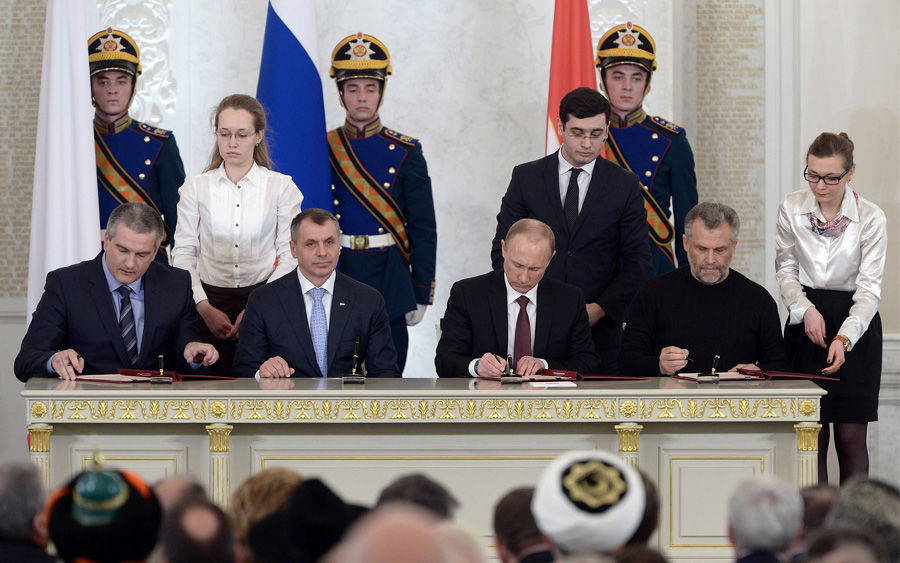
While Putin, Aksyonov and Konstantinov were rejoicing in the Kremlin, pro-Russian activists and “tourists” were trying to copy the “Crimean scenario” in the Donbas. However, this scenario initially lacked a key element – the Russian army.
Chapter 3
How Putin ignited southeast Ukraine
According to Putin, a “civil war” broke out in the cities of southeast Ukraine in the spring of 2014. Here is what his version of the events looks like.
Vladimir Putin
“As for the tragedy that is happening there, one should always look at the origin of the tragedy. The origin is the coup d’état, the armed unconstitutional seizure of power. As you know, part of the people of Ukraine did not agree with this and began to resist it. Despite Ukraine’s alleged aspirations to become a member of European civilisation, they began to fight those dissenters not by democratic means, but first with the use of special services and then with the full-scale use of armed forces.”
We have already dealt with what Putin calls a coup d’état, but the rest of the world knows as the removal of Yanukovych from power. Yanukovych’s escape would not have happened without the Euromaidan, and there would have been no Euromaidan if Russia had not decided to drag Ukraine into the Customs Union by any means necessary.
Now let us deal with the tragedy that unfolded in south-eastern Ukraine.
Southeast Ukraine – Donetsk, Zaporizhzhia, Luhansk, Odessa, Kharkiv – was indeed pro-Russian. According to the polls, the majority here was in favour of the Customs Union with Russia.
In January-February 2014, rallies against the Maidan were held in the cities of the southeast. In some places, public servants were forced to attend these rallies, while in others, they attracted sincere opponents of what was happening in Kyiv: communists, Cossacks and activists from pro-Russian groups.
Afterwards, rumours were long circulated in the Ukrainian press about some buses with Russians who were allegedly brought from Russia to the rallies in late February and early March. There may have indeed been such buses, but no evidence of mass “landings” of Russians was found back then. It is worth noting though that according to local media reports, the rallies were only attended by several hundred to several thousand people. Here’s a video from Donetsk taken on 23 February. And here’s Odessa, also 23 February.
On 26 February, pro-Russian activists in Kharkiv replaced the EU flag in front of the city council with the Russian flag. However, it was soon taken down.
In short, there were some protests, but with so few participants, it didn’t seem like they would lead to the collapse of the country. But then Russia intervened in Ukraine’s internal affairs. Supporters of the “Russian Spring” will tell us about it themselves.
One of the leaders of the Kharkiv anti-Maidan movement, Yury Apukhtin, left his memories of the events of 2014. It should be understood that Apukhtin is an ardent supporter of the “Russian Spring”, who was persecuted by the SBU and served time in a Ukrainian prison.
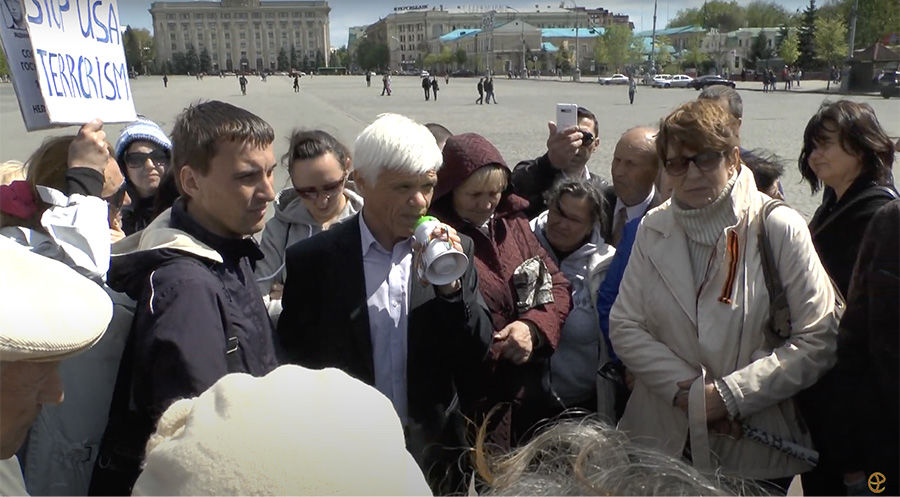
Here is what he writes about the events of late February – early March 2014.
Yury Apukhtin
“The new Crimean authorities and Russian support groups began inviting representatives from the regions to Crimea, persuading them to escalate protests and demand secession from Ukraine, promising full support and assistance. Since the beginning of March, emissaries from Crimea have also reached out to Ukrainian regions with similar proposals.”
So, it turns out that as soon as Aksyonov came to power in Crimea with the help of the Russian military, he and his team started to encourage the entire southeast Ukraine to revolt? Could Apukhtin be lying? Let us return to the intercepted call between Zatulin and Glazyev from late February or early March.
Konstantin Zatulin“I would like to say about other regions: we have funded Odessa, we have funded Kharkiv. We have accepted applications from other regions, but we will slow down for now. Because I have not solved the financial issue yet. And now I am left alone with my obligations. I have already paid the Cossacks the money that ten people promised them, but nobody gave them a f***ing thing.”
Does this mean that already in late February 2014 Russia was sponsoring pro-Russian activists in the southeastern cities?
That spring, Glazyev’s informal assistant Frolov corresponded extensively with the anti-Maidan branches in Kharkiv, Odessa, Donetsk and Luhansk. “A sum of about $100,000 is needed for Kharkiv at this time,” they demanded of him. “Glazyev is waiting for a plan of action with a budget estimate,” Frolov himself wrote to a pro-Russian activist from Odessa.

Estimates and lists of activists can also be found in the leaked mail of one of Surkov’s key employees, Boris Rapoport.
Here is an estimate that came to the Kremlin from Kharkiv: they require uniforms, combat boots, bulletproof vests, tasers, cars and payroll for the operatives. And here is a request from Donetsk: they need $400 thousand for 200 sets of gear in order to set up a permanent camp in the city centre and “prevent the protests from dying down”.
The situation is similar to Crimea, but there is one key factor missing – the Russian army. Why would pro-Russian activists raise the Russian flag if, to put it in Putin’s terms, there is no one to stand behind their backs? Unlike Sevastopol, there were no military bases in the southeast!
On 1 March, Putin got a pretext to introduce troops into Ukraine – the Federation Council gave him the right to do so. During the session, Chairwoman Valentina Matvienko and other senators kept repeating the same wording.
Valentina Matvienko
“The Federation Council has received an appeal from the President of the Russian Federation Vladimir Vladimirovich Putin regarding the use of the armed forces of the Russian Federation on the territory of Ukraine until the socio-political situation in that country is normalised.”
Putin likes everything to appear formally legitimate. Apparently, this is why the Kremlin needed appeals from the deputies of the southeast. “Come and protect us from the Banderovites, Vladimir Vladimirovich.” How do you get them to sign such appeals? Sergey Glazyev, a native of Zaporizhzhia, who in those days became one of the instigators of the protests in the southeast of Ukraine, will tell us all about this.
His tapped calls include a conversation that the Prosecutor-General’s Office of Ukraine dates to 1 March.
Sergey Glazyev“I have a direct instruction to stir everyone up, to stir up the people. The people must gather in the square and demand to appeal to Russia for help against the Banderovites. Specially trained people should knock the Banderites out of the building of the regional council, and then they should gather the regional council, create an executive body. Executive power should be transferred to the oblast executive committee and the police should be subordinated to this new executive authority”.
Note that he links the Federation Council’s authorisation of troop deployment to the street protests.
Sergey Glazyev“We need to bring people to the streets, to do it like they did in Kharkiv, to follow their example as soon as possible. Because you can see that the president has already signed a decree, the operation is underway, they are already reporting that the military is moving in. We shouldn’t just sit around.”
The briefing from Glazyev was not in vain. Appealing to Putin to bring in troops has become the main demand of the anti-Maidan protests in the cities of southeastern Ukraine.
This video was filmed in Donetsk on 3 March, at the square in front of the regional council. Pavlo Gubarev, the leader of the Donetsk anti-Maidan, a former activist of the neo-Nazi movement “Russian National Unity”, who in 2009 attended the camp of the pro-Kremlin movement “Nashi” at Seliger together with other future leaders of the Ukrainian anti-Maidan, speaks before the protesters.
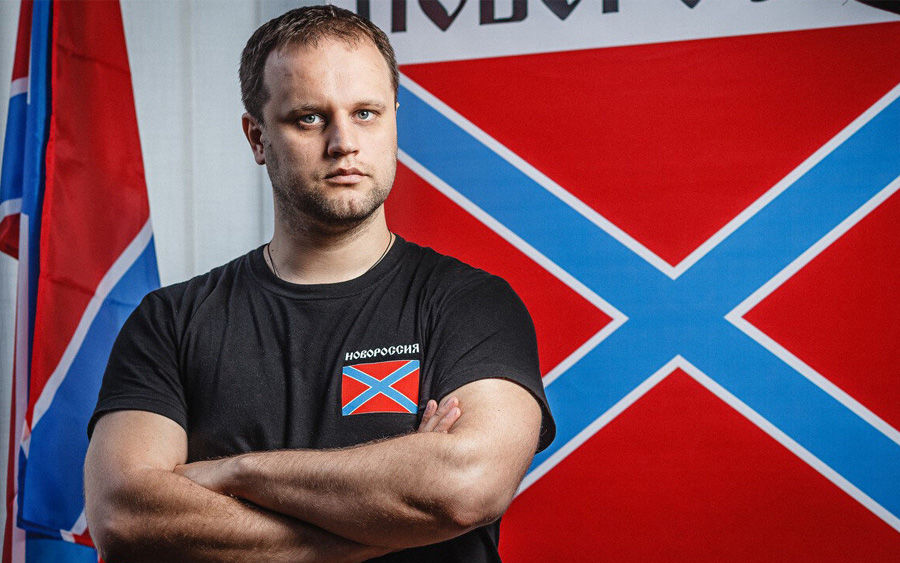
Pavlo Gubarev
“On behalf of the entire rally, I want to appeal to the Russian authorities and Supreme Commander-in-Chief of the Russian Federation Vladimir Vladimirovich Putin with a request to support the people of the Donbas and introduce peacekeeping troops to the Donetsk Oblast. Save us! Russia! Russia!”
And this is the Mariupol City Council, 2 March. Mariupol resident Irina Kurenkova, who appeals to Putin to send troops in this video, will become a refugee in 2022 and leave Mariupol after the Russian army comes to her city, just as she requested in 2014.
And this is Kharkiv, 16 March. The building of the Russian Consulate General. Protesters shout “Putin! Putin! Putin!” and also urge Putin to introduce troops.
Behind the Kharkiv anti-Maidan activists stans Arsen Pavlov, a Russian citizen and future field commander with the call sign “Motorola”.
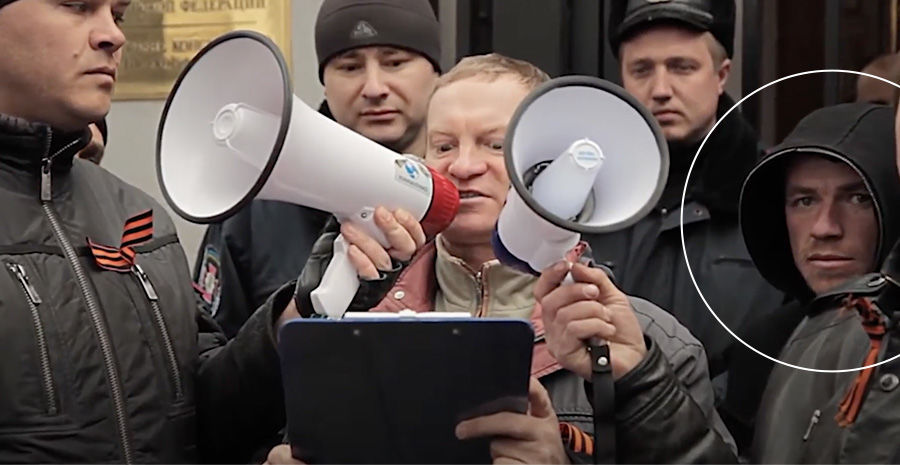
Motorola later recounted that he wanted to go to a real war and, when protests began in Ukraine, he wrote to local acquaintances and went to the neighbouring country – waiting for “an outbreak”, as he put it. Motorola, who worked at a car wash before the war, could indeed have come to Ukraine looking for adventure – a kind of political safari. But there were also such “tourists” whose connection with the Kremlin is more obvious.
For example, the Russian flag was hoisted over the Kharkiv administration by Mikhail Chuprikov, a Russian citizen and ex-activist of the pro-Kremlin Mestnye movement. He himself claimed that he no longer had anything to do with Mestnye, and had come to Kharkiv as a journalist. Nowadays, Chuprikov is a popular travel blogger. He refused to talk to Proekt about the events of 2014.
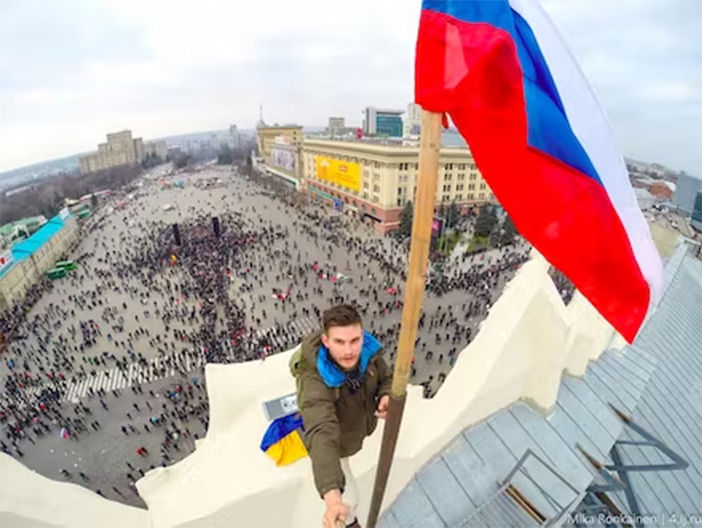
The emergence of people associated with pro-Kremlin youth movements in Ukraine is not surprising. Konstantin Goloskokov, commissar of the Nashi movement, was one of the curators of the Donetsk anti-Maidan protests. He sent to the Kremlin budget estimates for the protests and reported that pro-Russian activists in Donetsk numbered about 200 people, and that 10,000 people actually attended weekend rallies.
And the very same Kirill Frolov, whose mail has become an important source on the Kremlin’s plans for Ukraine, was sent to Odessa to stir up the people. Glazyev’s wiretapping includes a call Frolov made to him right from the rally at the Odessa Oblast Council.
Kirill FrolovSergei Yurievich, here is my report. There were a lot of people. A full square. So, because of this Anton [Davidchenko, one of the anti-Maidan activists]… most importantly, he called on the liberators of the Supreme Council of Crimea to liberate Odessa. So, roadblocks at the border of Odessa Oblast.
Sergey Glazyev You can’t leave. You must take this oblast council, gather all its members, and force it to make decisions.
Kirill FrolovWell, for that several people should fly in for one day to receive clear instructions. Besides, you told me to bring them.
Sergey GlazyevThe situation keeps developing. They have already taken the oblast councils in Kharkiv and Donetsk. We need to take the oblast council and gather the MPs.
Kirill Frolov Understood!
Sergey Glazyev And don’t leave until then. If you gather in a week, the Banderovites and the police will be there. They won’t let anyone in. We shouldn’t leave, we should keep going. If we just make some speeches and leave, it will end in defeat.
In form, it was an exact repetition of the Crimean scenario. Local pro-Russian activists take to the streets to protest. The “tourists” come to their aid. Together they storm government buildings and appeal to Putin for help. There is only one key difference: there are Russian troops in Crimea, whereas there are none in mainland Ukraine. As a result, the separatists stormed the oblast councils, but then quickly abandoned them. The efforts of pro-Russian activists alone were not enough to hold on to power.

Here is a great example. On 3 March, pro-Russian activist Valery Kaurov tries to storm the Odessa Oblast Council alongside a mob. And he calls Glazyev’s assistant with a reasonable question: what next?
Valery KaurovHello, Sergey. A group of activists and I have broken into the session. I’m going to make a speech now.
Sergey TkachukAh, you’ve broken into the session, got it.
Valery KaurovHelp, help, we need help.
Sergey TkachukHelp? We are now trying to solve this issue quickly, we call each other.
Without help from Russian troops, pro-Russian activists could not even take control of the Odessa Oblast Council building. And instead of appealing to Putin, local deputies opposed the introduction of Russian troops.
And Putin hesitated. He was bombarded with calls: the night after he received the permission of the Federation Council, he simultaneously talked to the presidents of the USA, France and the UN Secretary General. On March 4, he stated:
Vladimir Putin
“Regarding the introduction of troops, the use of troops. So far there is no such need. We see rampant neo-Nazis, nationalists, and anti-Semites in some parts of Ukraine. And if we see this lawlessness beginning in the eastern regions, we reserve the right to use all the means at our disposal to protect these citizens.”
The Kremlin has been pushing pro-Russian activists to storm regional administrations throughout the southeast Ukraine, claiming that the Crimean scenario was about to be implemented, i.e, that Russian troops were about to enter. But in fact, the Kremlin deceived them. The troops would be sent much, mch later.
In those days, Konstantin Zatulin, the Kremlin’s anti-Maidan curator, wrote sadly in his column for Izvestiya:
Konstantin Zatulin
“At this stage we are apparently not prepared to give the same kind of decisive support to our compatriots in Donetsk, Kharkiv and Odessa as we did in Crimea.”
And the Kyiv authorities were gradually coming to their senses after the Maidan. New regional heads were appointed. The security forces were starting to act more rigidly. А киевские власти постепенно приходят в себя после майдана. First arrests began – for example, of Pavel Gubarev, the leader of the Donetsk protest. He wasn’t arrested for his love of the Russian language though, but for separatism and calls for a neighbouring state to occupy his home country.
Not only law enforcers but also civilians were fighting the separatists. For example, in Zaporizhzhya, Maidan supporters armed with sticks attacked the anti-Maidan motorcade. The most violent confrontation unfolded in Kharkiv. Armed pro-Russian activists, among whom was Motorola, stormed the local office of the Right Sector, a fighting unit of the Euromaidan. The Right Sector responded by shooting. The fight went on for several hours, two pro-Russian activists were killed.
The arrests and the Right Sector have led to fewer and fewer people attending rallies. And the Kremlin was receiving angry letters from anti-Maidan activists. Here is one very eloquent letter from Andrei Novikov, secretary of the Odessa diocese, to Kirill Frolov (Novikov would soon flee from SBU persecution to Moscow).
Andrei Novikov
“The new Ukrainian authorities stormed the Donetsk Oblast Council and arrested more than 70 “separatists”, including Pavel Gubarev. In Donetsk, they did everything according to Russian instructions, as Sergey Yurievich Glazyev told us to do. Now is the moment of truth. Will Putin come, with an army, as he promised to do “in case of repression against Russian-speakers”? Or are all his and your calls nothing but bullcrap and provocation?”
But what did the residents of the southeast themselves think about the pro-Russian protests? In April, they were polled by Ukrainian sociologists. It turned out that the majority were against the seizure of administrative buildings. And most importantly, against the introduction of Russian troops to their homeland. After all, no one wants the collapse of their country or a war.
Results of surveys of residents of the south-east of Ukraine in April 2014

Data from the Kyiv International Institute of Sociology
Could it be that this poll was deceitful, and in reality people actually dreamed that the Russian army would come to Ukraine? Let’s give the word to the supporters of the so-called “Russian Spring” themselves.
Here is what Gubarev’s associate Sergey Tsyplakov recalled in this book:
Sergey Tsyplakov
“After unsuccessful attempts to seize administrative buildings and the capture of Pavel Gubarev, the protest began to slow down. Buildings were occupied or left”. They themselves admit: “The protest began to slow down”. Another quote: “The local elites kept themselves aloof. They should have seized weapons and dictated their own terms. But we watched the news from Crimea and hoped for Russia’s help.”
And here is a quote from Yury Apukhtin, an activist of the Kharkiv anti-Maidan, who we already know.
Yury Apukhtin
“The goals of the protests in the southeast have not been realised, they have only been achieved in Crimea, and this was possible not because of how organised and massive the protests were, but because of Russia’s intervention, without which Crimea would have met the same fate as the rest of the southeast.”
The Kremlin also knew that the protests were subsiding after the crackdown. But they optimistically believed that 5,000-10,000 people were still attending the rallies, although the footage from them and local media reports showed even fewer people turning up.
Supporters of the “Russian Spring” often ask – why did Putin, after threatening to introduce troops into Ukraine in 2014, never did so?
Putin himself vaguely explained it already after the outright invasion of Ukraine. He claimed that Russia was not ready for such a large-scale introduction of troops into its neighbour’s territory.
Vladimir Putin
“This also concerns our readiness for some more serious actions than the actions within the framework of the so-called Crimean spring. Over the previous years, we have done a lot in the field of import substitution. We have strengthened our financial system. Despite the expectations of the enemy, nothing has collapsed, everything is working. What would have happened in 2014? It is very difficult to say.”
The Kremlin could indeed carry out all sorts of calculations – financial, sociological and military. Which ones? The answer to this question can be found in the memoirs of the former Minister of State Security of the DPR, Russian citizen Andrei Pinchuk, who wrote a book about the events of the “Russian Spring”. Here is him presenting it in 2017 at the Moscow Book Centre.
This book features a conversation with a certain “statesman” who explains to Pinchuk why Russia did not introduce troops into Ukraine in the spring of 2014. Pinchuk does not reveal the name of this person, but it could be the head of Rostec and a close friend of Putin, Sergei Chemezov. During his time as Minister of State Security of the DNR, Pinchuk was officially employed by Rostec: Surkov’s people asked Chemezov to draw up documents in such a way as if Pinchuk had been on a business trip to Omsk.

In another episode from the book, a high-ranking interlocutor gives Pinchuk a folder with opinion polls conducted by the Kremlin in Russia and Ukraine.
Andrey Pinchuk
“Ukraine. Sentiments on the possible introduction of Russian troops, readiness to resist, degree of activity or passivity. Readiness for guerrilla warfare.
Russian segment. Perceptions of the possible introduction of troops. Reaction to possible losses (one of the appendices is even called “What will happen when coffins start arriving in Russia”). Analysis of the government’s approval rating in such a scenario.”
The mysterious “statesman” takes a long time explaining the pros and cons of annexation of eastern Ukraine in 2014 to Pinchuk. Yes, he uses the exact word – “annexation”. You can go to jail in today’s Russia for using this word.
“I flip through it. Calculations and schemes of allied relations, arrangement of anti-Russian forces, prospects for internal mobilisation of pro-Russian ones. Man, are the prospects really so poor?!”
The mysterious “statesman” replies to Pinchuk:
“You know perfectly well the mentality of the Ukrainian population. You should have no illusions about the current pro-Russian alignment of the eastern regions, or their over-activity. Amid the stirrings of a certain number of activists, the majority simply waited and were not ready to intervene in any particular way.”
So why did the war start if most people in Ukraine just wanted to live peacefully? Against whom did Ukraine deploy its army, if, according to the same book, the anti-Maidan was small in number and unarmed? Because Russia, afraid to bring in its troops, started to fight a hybrid war. Strelkov’s armed detachment arrived from Russian-controlled Crimea and started shooting.
Igor Strelkov
“Had our detachment not come to the Donbas and become the core of the resistance, the core of the ‘Russian Spring’ in the Donbas, it is likely that without this core, the ‘Russian Spring’ would have been nipped in the bud”, — Strelkov himself stated in 2020.
Chapter 4
How Putin started a real war
In the spring of 2014, a real war broke out in the southeast. Mutual exacerbation ensued very quickly. Shelling of towns started. Children began to die.
Satellite images, wiretaps, leaks, eyewitness videos. During the hot phase of the war in the Donbas, Russia left many traces of its direct interference in the affairs of its neighbour.
For instance, public data helped track down the Russian Buk missile complex that shot down the MH17 plane over Ukraine. This data was gathered by the Bellingcat investigative group.
Bellingcat also compiled a database of Russian military equipment used in the Donbas war, as well as a database of evidence showing that Ukraine was shelled from the Russian territory.
This evidence refers to the most intense phase of the conflict, when artillery and tanks were already deployed. But the most important thing is to understand who fired the first shot in this war.
According to Putin’s version, the Ukrainian military were the first to start shooting, following an order from then acting Ukrainian President Oleksandr Turchynov.
Vladimir Putin
“If it is true that the Kyiv regime has started to use the army against the population inside the country, this is a very serious offence against their own people. This is not an acute phase, this is a punitive operation.”, — Putin said in April 2014.
Putin was talking about the massacre in Sloviansk. Now let’s see what kind of “population” this was, and why Kyiv has led an army against it.
In late March, protest activity across the Donbas was down, with pro-Russian leaders arrested or on the run. A couple of weeks before the war, Sloviansk TV reported about the start of the planting season.
But at this time, the men of Sergey Aksyonov – the head of the newly seized Crimea – approached the surviving activists with a plan to ignite the protest into an outright wildfire with the use of weapons. At that point, Crimea was already fully under Russian control. So, in essence, this plan came from Russia.
It is important to stress: it is not Ukrainians who are telling about the Crimean messengers. Not journalists. The supporters of the “Russian world” themselves openly speak about it. In 2014, the SBU arrested Sergey Yudaev, one of the leaders of the anti-Maidan in Kharkiv. In 2014, he was non-stop streaming from the rallies. While in jail, Yudaev handwrote his memoirs about those events.

Yudaev honestly recounts the following. In early April, the men of Sergey Aksyonov, the head of Crimea, called pro-Russian activists from Kharkiv, Donetsk and Luhansk and invited them to Rostov to discuss a plan for a joint uprising. The meeting took place in early April. At it, it was decided that the three cities would act in sync with the support of Crimea.
Yudaev is not the only one who talks about the contacts of Aksyonov’s people with the Ukrainian anti-Maidan in early April. We know from other memoirs that around the same time activists from Odessa and Mariupol also received an offer to take up arms against the Kyiv regime from Crimea.
Yudaev is now at the front, helping the Russian military. When I asked him to tell me who the pro-Russian activists met with, he vaguely replied that “architects of future events” from “Moscow offices” had been in Rostov in those days. He refused to give any names, though.
What is known for sure is that several of Aksyonov’s associates were responsible for communicating with the anti-Maidan activists in the southeast, including his adviser, Russian citizen and retired FSB officer Girkin-Strelkov. He definitely coordinated his actions with activists from Donetsk. Pavel Gubarev also writes about this in his book “Torch of Novorossiya”.
Gubarev himself was in a Kyiv prison at the time, his wife Ekaterina went to Rostov instead. Ekaterina Gubareva recalled:
Ekaterina Gubareva
“Strelkov said things that literally stunned me. It seemed fantastic to me – such super-secret information!”
Another quote:
Pavlo Gubarev
“Strelkov had only a first conversation with Katya at that time. Then co-operation began to develop. Strelkov said that it was now necessary to spread the protest against the Kyiv junta over as large a territory as possible (to disperse), and to prepare for a real seizure of weapons. Which is exactly what would happen on 6-7 April 2014. After the seizure of weapons, Strelkov’s detachment was to enter the Donbas from Crimea.”
So, let’s re-emphasise. The Kremlin knew that the protests had died down by the end of March. They also knew that the annexation of Crimea had caused a rise in anti-Russian sentiment in Ukraine. And according to polls, residents of the southeast did not support building seizures and violence. So what do people connected to the Kremlin do next? They add fuel to the fire to ensure more violence.
6 April, Sunday. Another set of rallies are scheduled in Donetsk, Luhansk and Kharkiv. Further events occur almost simultaneously.

In Donetsk, the rally ended with another storming of the administration. At night, in accordance with the plan outlined in Rostov, the militant wing of activists stormed the Donetsk headquarters of the SBU. After the storming of the SBU building, the pro-Russian activists got the weapons they desired. The next day they announced the creation of the Donetsk People’s Republic.
There was also a rally in Luhansk on 6 April, but the protesters there didn’t storm the administration, going straight for the SBU building. Pro-Russian fighters also seized weapons in Luhansk. The SBU building was surrounded by barricades. In late April, the Luhansk People’s Republic was proclaimed right on the street.
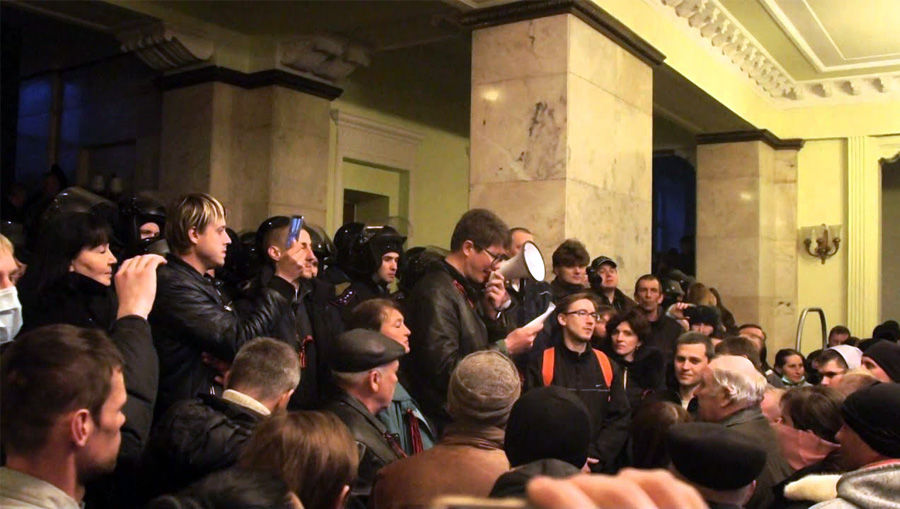
The Kharkiv People’s Republic was proclaimed on 7 April in the foyer of the administration building. A template for the declaration was sent from Donetsk. On 8 April, special forces from Vinnytsia put an end to the Kharkiv People’s Republic. The administration building was cleared.
It was more difficult to clear Donetsk and Luhansk, however: there, the anti-Maidan activists had seized weapons. According to the plan approved in Rostov, Strelkov’s detachment was to enter there next. In Crimea, Strelkov gathered a detachment of fifty people made up of retired servicemen from Ukraine and Russia. These men helped the Russian army seize the peninsula.
Igor Strelkov
“There was not a single active Russian military officer among them. There were reserve officers of the Ukrainian armed forces. There were a few people who had gone through the war in Chechnya, but as privates and sergeants. Two of them had been in the GRU special forces. In fact, three quarters were citizens of Ukraine, and most of them were not even Crimeans, but people who had come from Kyiv, Odessa, and Kharkiv”, — Strelkov recalled.

Strelkov’s campaign was funded by the aforementioned Orthodox entrepreneur Konstantin Malofeev. The financial manager was Alexander Borodai, former PR man of Malofeev and advisor to Aksyonov. Borodai had known Strelkov since the 90s.
Alexander Borodai
“I was indeed behind his march to Crimea and then to Sloviansk. And frankly, it was me who happened to bring him into this whole story, if you will”, — he said in 2014.
Here is how former State Security Minister Pinchuk described Borodai’s role in his memoirs:
Andrey Pinchuk
“In the spring of 2014, the events in Crimea and the subsequent incorporation of the peninsula into Russia were a big impetus for the acceleration of processes. “Walkers” from the Donbas and other pro-Russian regions of Ukraine reached out to Crimea with a request to “do as you did”. There were no legal prerequisites for a repetition of the Crimean scenario, but there was hope that the desperation and massive popular outburst would turn the situation around.
Those involved in the Crimean events responded to the call. Alexander Borodai and the forces behind him sent Strelkov to the borders of the Donetsk Oblast to study the situation and establish cooperation with the protest leaders”.
And here is Borodai’s own account of his meetings with Strelkov from the book “85 Days of Sloviansk”:
Alexander Borodai
“A couple of days before Strelkov entered the Donbas, we met in a cafe at the Rostov airport. I handed him substantial funds. I regularly handed him funds both before, in Crimea, and after, when Strelkov was in Sloviansk. We are talking about hundreds of thousands of dollars to support Strelkov’s detachment and the people’s militia. That was non-state money. It is not hard to guess who it came from.”
Participants of the events do not hide the fact that it was Malofeev. Strelkov himself said that “the uniforms were purchased with Malofeev’s money and intended for the Crimean battalion” and that “they simply did not have time to reach Crimea – we managed to receive them in Rostov just a day before the border crossing.”
On the night of 11-12 April, Strelkov and half a hundred armed fighters crossed the border between Russia and Ukraine in the Rostov Oblast.
Alexander Borodai
“Strelkov independently chose Sloviansk as his destination. There were some considerations and circumstances that made him choose Sloviansk. In particular, there was the most serious and consolidated group of local supporters there”, — Borodai recounted.
In addition, Sloviansk is a transport hub on the way to the Donbas. Strelkov held it for several months.
Gubarev’s men met Strelkov at the border. They had rented a lorry, but the driver did not know who he was to drive. Strelkov asked: “Is the driver your own or an ‘expendable’?” Here is what he told about this:
Igor Strelkov
“The Nova Poshta driver really didn’t know where he was going. When I found out about it, I just decided to scare him. I had no plans to shoot him: I had to scare him, and do it in such a way that he would not even think of jumping out at some checkpoint. Because I saw his reaction when heavily armed men started loading into the back of the truck.”
Strelkov’s threat made an impression not only on the poor driver. One of Gubarev’s men with the call sign “Buinyi” recalled in his book:
Buinui
“Do you know how Strelkov’s men differed from the locals? They smelled of war and some kind of unstoppable determination. They came in and basically understood that they would have to fight and shed blood, and we believed until the last moment that it would be like in the Crimea. That we would quickly show that we are decent guys who want want independence, and Ukraine will say, ‘All right, go in peace!’ We hoped that the AFU would not fight us.”
On the morning of 12 April, Strelkov’s detachment arrived in Sloviansk and went to seize the city’s police station. This way Strelkov got even more weapons. Soon the first shots were fired. The locals asked the armed strangers who they were and what they were doing in their town. Strelkov’s men replied that they were the “green men from Crimea” and had come to “ensure a bright future for the townspeople”.

This bright future turned out to be the transformation of the city into a centre of hostilities. On 13 April, Ukrainian Acting President Turchynov announced an anti-terrorist operation. Ukraine launched a military operation against Strelkov’s detachment using ground units and aviation. They fought ineptly at first. But who could seriously prepare for such a war?
It is not by chance that we describe Strelkov’s arrival in such detail. After all, the supporters of “Russian world” themselves admit that there would have been no war without it.
Alexander Borodai
“As soon as Strelkov’s detachment appeared in Slovyansk, the fighting started”, — Borodai honestly admitted in an interview with Ksenia Sobchak.
Strelkov himself, however, claimed that he acted independently.
Igor Strelkov
“I got involved in both Crimea and the Donbas by myself. Especially in the Donbas – because Malofeev was against the campaign in the Donbas. But I was in favour. I am first and foremost a volunteer and only then an FSB officer.”
On the first day of the fighting, 13 April, Strelkov called Borodai and Malofeev with a report using a regular mobile phone. Here is their conversation:
Alexander BorodaiPut Strelkov on the phone. Right now.
Igor StrelkovHail, Konstantin Valeryevich!
Konstantin Malofeev Hello, good morning! Well, how are things?
Igor StrelkovWe repelled the attack, the enemy retreated in all directions with heavy losses.
Konstantin Malofeev Have you reported to Aksyonov?
Igor StrelkovNo, I haven’t. I haven’t managed to establish contact with him yet.
Konstantin Malofeev Good, then call him. I’m meeting him here tomorrow, he’ll fly in tonight, but try to call him with the report as well.
Igor StrelkovRoger, of course.
Konstantin Malofeev As for the further reconnaissance, you know it yourself. Now the whole world is looking at this very geographical point, so there’s no need to be too smart anymore.
“Report”, “roger” – only bosses are spoken to like that. And this boss clearly does not mind what Strelkov has done. The roles of Malofeev and Aksenov are clear – one gave Strelkov money, the other gave him people. But who gave permission for an armed raid into the territory of a neighbouring country?
The book “85 Days of Sloviansk” contains the following story by Borodai. He says that after handing over the money to Strelkov in Rostov, he returned to Moscow. And there, right at the airport, he crossed paths with a certain Russian delegation that had just returned home from foreign negotiations on the Ukrainian crisis. They were aware of Strelkov’s upcoming campaign.
If Borodai’s revelations are to be believed, Strelkov’s campaign was not an enterprise of Malofeev and the head of Crimea, Aksyonov. People in top government echelons knew about these plans. The question is who and to what degree.
By this time, Putin’s aide Vladislav Surkov had become the key curator of the Donbas in the Kremlin. Even Ukrainian activists who used to work with Glazyev were now sending reports to Surkov – for example, reports on bail payments in Kharkiv for arrested anti-Maidan activists.
But Surkov, of course, was not the main boss. He supervised the political issues of the Donbas. The military was the domain of the security forces, a person in Surkov’s entourage told us. In fact, Surkov himself admitted this in open communication. Here is a transcript of his conversation with Borodai in summer 2014:
Vladislav SurkovHello.
Alexander BorodaiYes, Vladislav Yuryevich.
Vladislav SurkovWell, I talked to our senior colleagues there. The most senior ones, the top brass, who are responsible for all this military business. They say they know there’s a need for a turning point. I’ve talked their ears off. They say, yes, we understand, we’re preparing. But I can’t vouch for the quality of these answers, you understand. Even though they are my comrades, I can’t trust them completely on whether they are preparing something or not.
What were the names of these senior colleagues?
Among Surkov’s leaked emails is a letter from Malofeev from mid-May with a list of candidates for the DPR government. This was one month after Strelkov’s detachment came in. At the bottom of the list is a note: “Ask Vladimir Ivanovich’s opinion.”
Who is this “Vladimir Ivanovich”? This name is often found in phone conversations intercepted in the summer of 2014. Pro-Russian fighters call him the big boss from Moscow and ask him for military assistance. For instance, Bellingcat and BBC later proved that FSB General Andrei Burlaka could be hiding under the alias “Vladimir Ivanovich”. An analysis of the voices of “Vladimir Ivanovich” and Burlaka showed a complete match.
Putin’s aide, head of Crimea, FSB general – aren’t there too many high-ranking people involved at once in Russia’s hybrid invasion of Ukraine? And can we really that Strelkov acted on his own?
The natural question after examining all this abundant evidence is: Did Putin know about the preparations of Strelkov’s unit? Did he coordinate Strelkov’s campaign? Because otherwise it would appear that all these people, like Aksyonov, Malofeev and Surkov, acted at their own risk. This question is one of the main “white spots” in the history of the beginning of the war. Strelkov himself has not given an answer to this question even in public conversations with his supporters.
However, the extent of Putin’s involvement in the Donbas affairs in 2014 is shown by one wiretap from the case files of the international tribunal on MH17. In it, Aksyonov’s aide describes how decisions are made to supply weapons to the separatists.
Aksyonov’s aide
“People flew to Moscow, asked for a week’s break. This decision is personally made by the First Person. The very first. They tore me a new asshole today and said it’s up to no general or defence minister. That’s it. As they said, the First Person is personally responsible to the people.”
War is not a special operation that Putin is so fond of. It’s easy to start, but hard to finish. It may not go according to the plan you set out. For example, instead of cowering and giving in without a fight, as they did in Crimea, the enemy can fight back.
Ukraine began to retake Sloviansk and surrounding towns from Strelkov’s men. Exacerbation came to other Ukrainian cities as well. Pro-Russian activists were now increasingly perceived as supporters of armed separatism. In Zaporizhzhia, they were egged several times and almost beaten up at a rally. On 2 May, clashes between Maidan and anti-Maidan protesters in Odessa eventually led to the tragic deaths of 48 people.
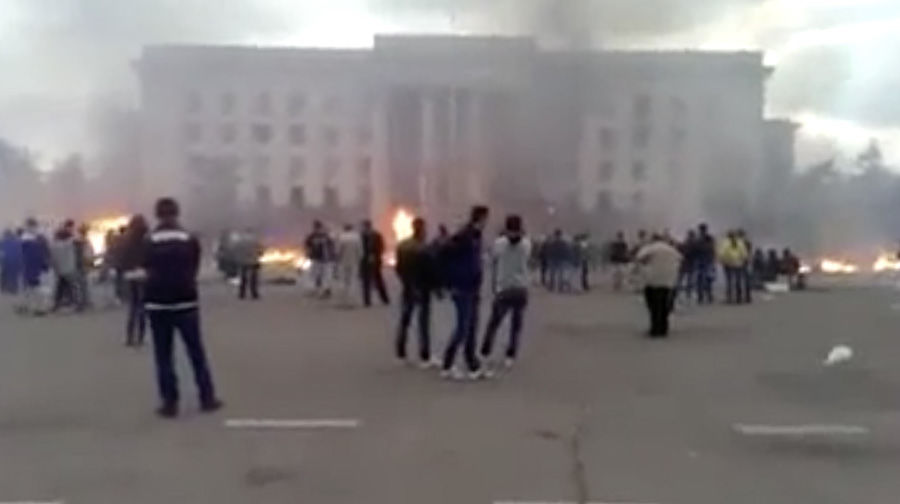
The Kremlin responded by further escalating its aggression and began supplying weapons to Ukraine. For example, military correspondent Zhuchkovsky honestly writes about this in his book about the defence of Sloviansk.
Alexander Zhuchkovsky
“In May and June, the Sloviansk garrison’s armoured fleet began to expand little by little. Armoured vehicles were coming from the ‘mainland’ to the border, where they were picked up by representatives of the four military forces of the DPR.”
The “mainland” is, of course, Russia. Further on, Zhuchkovsky also honestly lists what arrived in Sloviansk. Let us remind you that his book is freely available in Russia.
Alexander Zhuchkovsky
“In total, about ten columns with armoured vehicles, mortars, various weapons and ammunition were sent to Slovyansk between the end of May and June. In each column there were two or three Ural trucks with shells for Nona SPGs and mortars. During the entire time of the defence of Slovyansk, up to 1,800 automatic rifles were received from the ‘mainland’.”
These automatic rifles were taken by volunteers from Russia, among others. The supporters of the “Russian Spring” themselves say that in 2014-2016 at least 35 thousand volunteers from Russia arrived in Ukraine. There is also an estimate of 50 thousand. Imperialists, National-Bolsheviks, outright neo-Nazis and mere adventurers. The war started by Putin attracted those who thought that the insidious West was advancing on the “Russian world” and that they had to defend it with weapons in their hands. For some, it was just a safari – an opportunity to shoot live people in a neighbouring country.
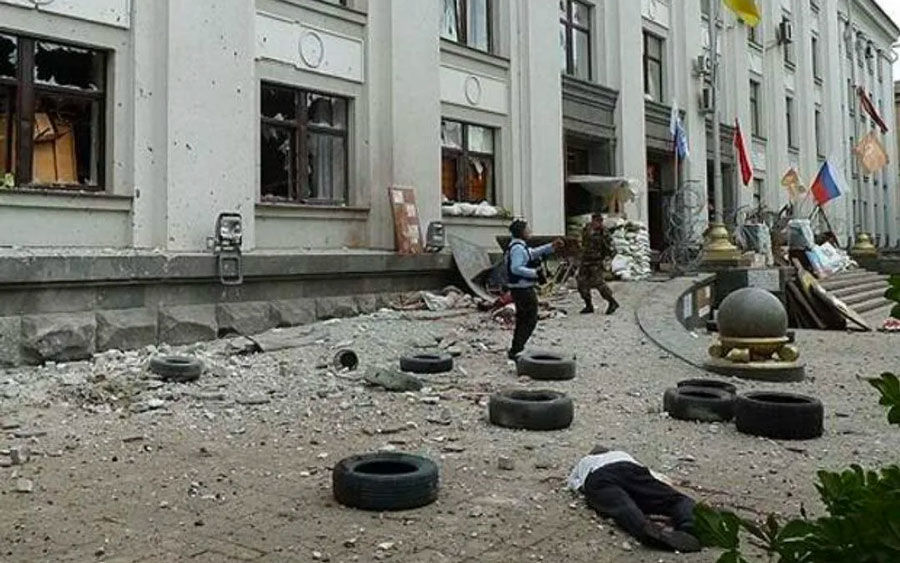
The war zone was gradually expanding. On 2 June, Ukrainian aircraft attacked the administration of Luhansk. The end of May saw the beginning of a long battle for Donetsk airport, where the Ukrainian military had gained a foothold. More than 30 volunteers from Russia were killed in the first battle. A list of victims was sent by the DPR authorities to Surkov a little later. Some of the people on the list had no names, but a note: “No head, right side tattoo”. In 2016, their names were embossed on a memorial plaque near a church in the Moscow Oblast.

By the end of June 2014, the war was already underway in a large part of the Donetsk and Luhansk oblasts. The tactic of the Ukrainian armed forces was now to take control of the border to cut off the separatists from arms supplies from Russia and the influx of fresh volunteers. What did Putin do in response? He escalated further.
Russia began shelling Ukrainian positions from its own territory. De facto, this already meant participation of the Russian army in the conflict. The Kremlin, of course, denied it, but Bellingcat found evidence of the shelling on Google satellite images. Here’s one example. On the Ukrainian side you can see traces of craters, and on the Russian side are scorched spots on the soil and tractor tracks in the fields.
In the second half of the summer, the military situation for the DPR and LPR became critical. Here is how it was described by then DPR Prime Minister Borodai:
Alexander Borodai
“A complete mess, the situation is in fact completely rotten. It’s a complete mess. There’s a heptarchy of commanders in the city, the military situation sucks. The DPR now looks like a dick with Donetsk as the bell end and, in general, the prospects are poor, I can honestly tell you.”

Here is what this “dick with Donetsk as the bell end looked like in early August. Only a small section of the border was under the control of the pro-Russian forces. The supporters of “Russian world” themselves admit: the DPR and LPR could only last until autumn.
Alexander Zhuchkovsky
Troops were brought in, but not openly, like in 2022, but in a hybrid way. This was the next level of escalation from Putin.
Troops were brought in, but not openly, like in 2022, but in a hybrid way. This was the next level of escalation from Putin.
Even the new head of the DPR, Aleksandr Zakharchenko, who replaced Borodai, the Vikings, mentioned the arrival of the Russian military together with Russian armoured vehicles in August 2014.
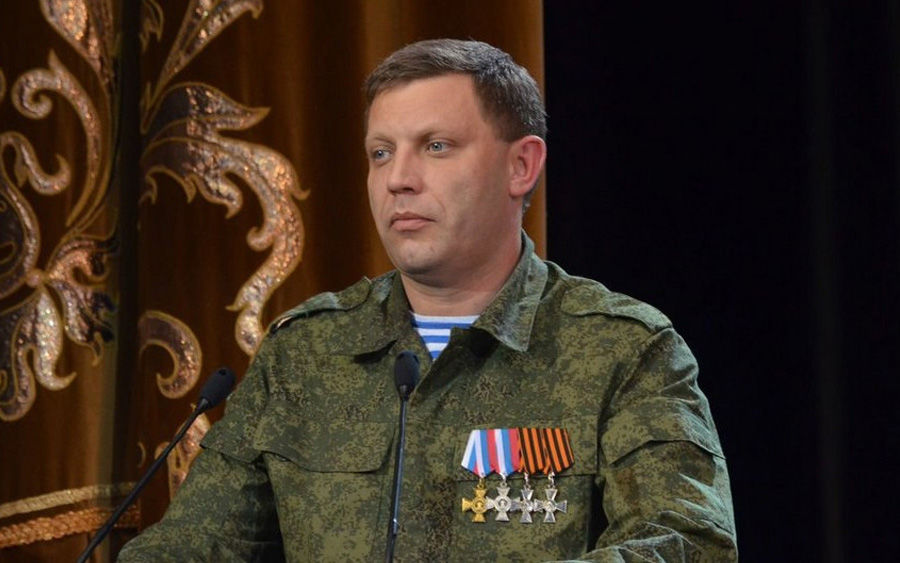
Aleksandr Zakharchenko
“In the near future, a number of counterattacks will be carried out, which will make it possible to push the border back as far as Novoazovsk. Combat reserves have been assembled for the reform of the army: 150 pieces of weaponry, including about 30 tanks and the rest being IFVs and APCs, and 1,200 soldiers who were trained for four months on the territory of the Russian Federation”.
And in 2023, this was honestly admitted by Alexander Khodakovsky, one of the leaders of the DPR.
Alexander Khodakovsky
“And then a miracle happened! Help came! At that time, of course, it was not customary to talk about it. We kept saying that we were doing everything on our own. Although this was, of course, not true. Limited ‘resources’ from Russia came in and helped us.”

In the second half of August, a lot of testimonies about the deaths, woundings or captures of Russian military personnel in Ukraine came in. The most famous case was the death of a group of Pskov paratroopers; the wreaths on their graves told the world much more eloquently than OSINT that Russia had essentially introduced a regular army into Ukraine. Back then, RBC and Dozhd collected a database of evidence about the presence of the Russian military in Ukraine. Here is a similar database from the Atlantic Council. Finally, here is an investigation by the Conflict Intelligence Team into the presence of Russian troops in Donbas at that time.
Several counter attacks were carried out with Russian military assistance: Ukrainian forces were pushed back to Mariupol, Novoazovsk on the Sea of Azov came under DPR control, and AFU soldiers were trapped in a pocket near the border town of Ilovaisk. Evidence of the presence of Russian troops at Ilovaisk is gathered here, for example.
In September, a ceasefire agreement was concluded in Minsk, under which Ukraine pledged to decentralise the governance of Donbass. The first Minsk agreement stopped the fighting on a line that did not suit both sides. There was a bulge near Debaltseve that threatened the AFU with a “sack”, Horlivka was semi-encircled, and Ukrainian forces held the Donetsk airport.
In early 2015, fighting resumed. The separatists were led by several generals from Russia, and reinforcements came once again in the form of regular Russian troops.
Yuri Yevich, a doctor and Strelkov supporter who served as a volunteer in Donbass, spoke honestly about officers from Russia in his book “In the Donbas Trenches”.
Yuri Yevich
“In late January [2015], the leadership in our brigade [of the DPR First Army Corps] changed. The general who organised the brigade from scratch left. After all, volunteer officers used to come to us on their holidays, instead of spending that time with their families, they would help us learn the hard science of war.
I have the fondest memories of this officer, the chief of staff and other officers who served in our brigade during that period. But, unfortunately, not everyone was so decent and professional. General Sokolov arrived in place of the departed general. Call sign ‘Brest’.”
According to the SBU, the officer hiding behind the call sign “Brest” was Major-General Igor Timofeev.

Supporters of the “Russian Spring” tell a lot about Russian assistance in their memoirs, either without hiding anything at all, or using the euphemisms “northern wind” or “military trade”. Here is how former DPR Minister of State Security Andrei Pinchuk describes the battle for Debaltseve.
Andrei Pinchuk
“The corps staffers are indecisive. There are no forces left for the assault, everyone is scattered along the front line of the Debaltseve offensive. But we insist. We are strengthened by Vanya Sever’s battalion of the Third Brigade, which should carry out a flank attack”.
Needless to say, there was no “Vanya Sever’s battalion” in the DPR army – this is an obvious euphemism for Russian troops. Another supporter of the “Russian Spring” admits this in a book that is freely available in Russia.
“The “northern wind” is a euphemism used by the militias to refer to the Russian military assistance. It was not customary to talk about this assistance (which arrived in late August 2014) directly so as not to “expose Russia to the West”. However, it was not a secret for anyone in the world, and over time, participants of the Donbas war directly or indirectly recognised the participation of Russian troops in the war”.
The symbol of this second stage of the hybrid Russian invasion, was the Buryat tankman Dorzhi Batomunkuev, who was burned near Debaltsevo. “We knew what we were doing and what could be,” Dorzhi stated at the time.
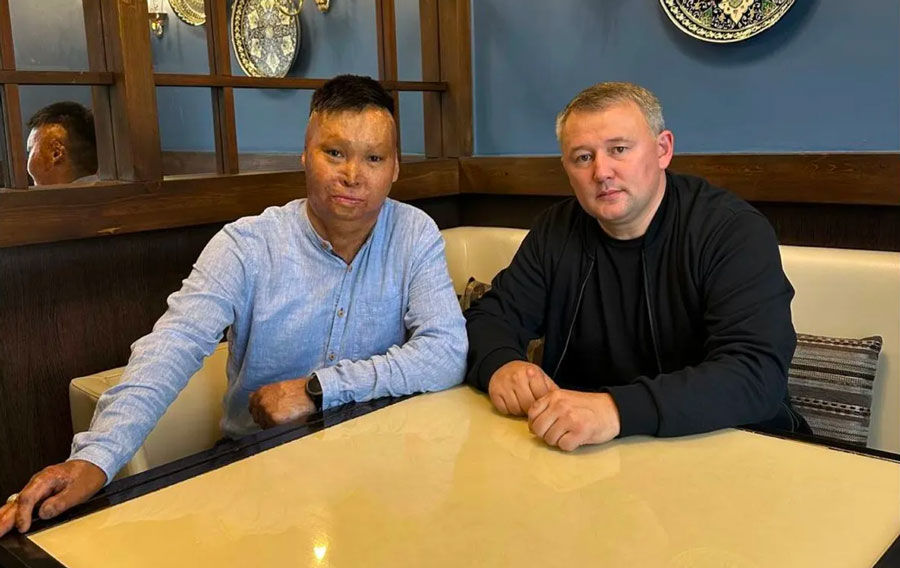
Eight years later, in response to a request to talk about the war that disfigured his face, Dorzhi wrote to a Proekt correspondent: “We are doing everything right. Our brothers are working.”
In February 2015, the second Minsk agreements were signed in Minsk. Commenting on them, Putin once again did not mention Russia’s participation in the war:
Vladimir Putin
“Of course losing is always bad, of course it’s always a misfortune for the loser, especially if you lose to yesterday’s miners or tractor drivers.”
Among the materials of the MH17 case considered in the Hague Court is a conversation between Putin and LPR head Igor Plotnitsky. The international investigation group dates this conversation to 2017.
Vladimir PutinIgor Venediktovich, good afternoon.
Igor PlotnitskyYes.
Vladimir PutinGood afternoon to you, hello!
Igor PlotnitskyYes, hello, Mr President!
Vladimir Putin How are you doing?
Igor PlotnitskyYes, thank you, Vladimir Vladimirovich, so far so good.
Vladimir Putin So far so good? How do you assess the… military aspect?
Igor PlotnitskyThe military aspect, it seems to me, is at a fairly good level, one cannot say that we’re somehow weak in this regard…
For the MH17 investigation, this conversation is possible evidence that Putin was personally involved with the separatists. Do all these wiretaps, leaks, and most importantly, the confessions of the supporters of “Russian world” themselves, leave any doubt as to who is ultimately to blame for the MH17 crash, who started this war back in 2014, and who in 2022 could not stop and turned hybrid warfare into an outright one?
Let’s summarise
- Strelkov’s unit did pull the “trigger of war”. It did not act on its own, and the chain of decision-making probably goes all the way back to Putin himself.
- The Euromaidan would not have happened if Putin had not pressurised Yanukovych and forcibly dragged Ukraine into the Customs Union.
- The Euromaidan did not automatically mean that Russia would seize Crimea. But Putin went ahead with the annexation, using tales about protecting Crimeans from the dreaded “Kiev Nazis” as an excuse. De facto, he started the annexation process when the friendly Yanukovych was still president.
- He didn’t stop at Crimea and decided to ignite the southeast. He failed to ignite it in any significant way, but he decided not to stop there either. Strelkov was sent to Sloviansk with weapons, and his campaign was synchronised with the seizure of SBU arsenals in Donetsk and Luhansk. Ukraine fought back, and Russia began to help armed pro-Russian groups, eventually de facto introducing troops.
So who started the war then? Putin.

Editor — Roman BadaninFact-checking — Ekaterina Reznikova